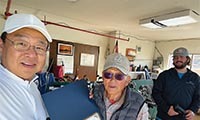Many trade stocks, and many lose money. (About 80 percent.)
ENCINITAS, California
REMEMBER THE DAY traders?
They were hard to miss during the tech-stock mania a decade ago, when the Nasdaq seemed like a casino built by morons and a chimp with darts could pick winners. You would hear about these guys ? nearly all of them were guys ? and wonder: Could anyone make a living this way? And if the answer was yes, why were the rest of us suckers still holding down regular jobs?
No doubt, it’s been a long time since a question like that troubled your imagination. And perhaps you assumed that the twin calamities of the Internet crash and the Great Recession had doomed the day-trader species in the unruly jungle of American capitalism. But some dreams refuse to die, and few, it seems, are more resilient than the dream of beating the market while sitting home in your underwear.
Or, if you are Andy Lindloff, a pair of jeans and a black waffle-pattern shirt. “Banks are seeing a nice little lift,” he says, staring at computer screens one recent Wednesday morning, sipping coffee. “The European banks are up, so that may bleed over to ours. Bank of America might be one to watch.”
Mr. Lindloff, 49, is sitting in his living room here in a city known as “surfer’s paradise,” just north of San Diego. Surrounded by the playthings of his daughter, he appears to be alone. In fact, he has plenty of company. With a handsfree headset, he is speaking to Steve Gomez, his partner in Today Trader, a two-year-old Internet venture that is “about helping traders find success through virtual technology,” as it says on the company’s Web site.
The company charges aspiring traders $199 a month for a live, real-time view of Mr. Lindloff’s computer screen, along with the running banter, commentary and advice that he and Mr. Gomez provide through the morning.
The service is billed as a chance to look over the “virtual shoulder” of two veteran stock traders, but you don’t really see anyone’s shoulder. It’s more like staring at the instrument panel of a jet while eavesdropping on the pilots, plus the ceaseless tap-tap of a keyboard.
When the market opens, 21 subscribers are logged in. This is the new frontier in do-it-yourself trading. Today Trader and its rivals are tiny operations, and they have modest followings. But they are harnessing all the crowd-sourcing features of the Internet circa 2010: You- Tube, Twitter, and companies like GotoMeeting, a Web conferencing service.
They are also harnessing a lot of market-related rage. The gruesome stock plunge of late 2008 and early 2009 was a searing moment for many people. Even many of those who took the safe route and years ago bought index funds have seen little upside. Look at the performance of the Standard & Poor’s 500, the most popular index out there. If you put $1,000 in it in 1999, you now have slightly less money in your account .
If the motto of the original day-trade boom was, “If the pros can do it, so can we,” the motto today is, “We can’t do much worse than the pros.”
“There’s this idea out there that retail investors are dumb,” says Howard Lindzon, the cofounder of StockTwits, which curates a gusher of stock tips and financial news alerts tweeted by 20,000 regular contributors. “Well, it turns out that the institutional investors are pretty dumb. They nearly blew us all up with leverage.”
Of course, anyone hoping to join the day-trade caravan had better wear a seat belt, as Mr. Lindloff’s experience on this Wednesday morning demonstrates. Before lunch, he will buy and sell about 44,000 shares, in 17 trades. He starts off poorly, losing about $500. But a timely bet on a company called Rackspace Hosting (“I don’t know what they do,” he says), as well as quick investments in Applied Materials, Eagle Bulk Shipping and a few others, have turned things around.
“Up $210,” he says, removing his headset. Factoring in commissions, he has made $60.
It is hard to say how many day traders are currently working in the United States. Brokerage firms track the activity and demographics of their customers, but they have been reluctant to share that data. About the most we know is that the day traders skew male, and the number of trades per $100,000 in client dollars is a little less than half what it was back in 2000, according to the Charles Schwab brokerage firm.
Even that figure seems high.
Mr. Gomez and Mr. Lindloff are among the few who started day trading in the late ‘90s and never stopped. For years, Mr. Gomez was a manager at a selfstorage facility, but he couldn’t resist trading commodities during office hours, and he had a hard time keeping his mind on his work. Mr. Lindloff worked at an Isuzu dealership for years, then made cold calls ? knocking on doors ? for Edward Jones, the brokerage firm. He left after three months.
“I knew I wanted to trade,” he says.
How good are they? Mr. Lindloff, who Mr. Gomez says is the more skilled of the two, says he has averaged $100,000 to $120,000 a year for the last 10 years, even during the worst part of the recession. With low expenses, he lives comfortably, though hardly extravagantly.
“I basically have $80,000 to $100,000 in my trading account every day,” he says, “and take my earnings out of that account to live.”
It is, to be sure, an odds-defying performance. The great mass of studies point to the same conclusion: trading is hazardous to your wealth, as an academic paper memorably put it. The losers far outnumber the winners.
Exactly how far is clear from one of the most comprehensive looks at the subject in a yet-tobe- published study conducted in Taiwan. (The country is ideal for this kind of research because all trades go through one place, the Taiwan Stock Exchange, which is willing to share the information.)
The authors sifted through tens of millions of trades, from 1992 to 2006, and found that 80 percent of active traders lost money.
“More importantly, we found that if you were to look at the past performance of these traders, only 1 percent of them could be called predictably profitable,” says a co-author, Brad M. Barber, a finance professor at the University of California, Davis. Everyone else, it seems, was on a short-term winning streak. Even those who did modestly well found their that profits were wiped out, and then some, by transaction fees like commissions and taxes.
“It’s not impossible to make money actively trading,” Mr. Barber continues. “There are slivers of people out there who are quite good. And everyone thinks they will be in that group of 1 percent.”
So why do people persist in this line of work?
“The technical term is thrillseeking,” says Hersh Shefrin, a professor of behavioral finance at Santa Clara University in California and author of “Beyond Greed and Fear,” an exploration of investors’ mindscapes.
Also, he says, “people enjoy trading.”
The Intelligence column will return next week.
By DAVID SEGAL
스마터리빙
more [ 건강]
[ 건강]이제 혈관 건강도 챙기자!
[현대해운]우리 눈에 보이지 않기 때문에 혈관 건강을 챙기는 것은 결코 쉽지 않은데요. 여러분은 혈관 건강을 유지하기 위해 어떤 노력을 하시나요?
 [ 건강]
[ 건강]내 몸이 건강해지는 과일궁합
 [ 라이프]
[ 라이프]벌레야 물럿거라! 천연 해충제 만들기
 [ 건강]
[ 건강]혈압 낮추는데 좋은 식품
[현대해운]혈관 건강은 주로 노화가 진행되면서 지켜야 할 문제라고 인식되어 왔습니다. 최근 생활 패턴과 식생활의 변화로 혈관의 노화 진행이 빨라지고
사람·사람들
more
“취미생활로 다진 친목… 선후배들과 만든 모교사랑”
사진러브한인 사진 동호회 사진러브(회장 크리스 고)는 13일 용수산에서 송년모임을 갖고 한 해를 마무리하는 뜻깊은 시간을 가졌다. 이날 모임에…

[홀인원] 이상원 박사
일반외과 전문의 이상원(왼쪽) 박사가 지난 9일 뉴포트비치 소재 골프장 9번 홀(152야드)에서 레스큐 클럽으로 친 샷이 그대로 홀에 빨려 들…
[송년행사 게시판] 재미시인협회
재미시인협회(회장 지성심)는 오는 20일 오후 4시 가든스윗호텔에서 한 해를 마무리하며 동인지 ‘외지’ 제35집 출판 기념회와 ‘제23회 재미…
[송년행사 게시판] 향군단체 연합
6.25 참전유공자회와 대한민국 육군협회 등 남가주 지역 향군 단체 연합은 19일 오전 11시30분, 용궁에서 송년 행사를 개최한다. 드레스코…
[송년행사 화보] “이웃과 함께 나누고 지인과 함…
KYCC13일 윌튼 플레이스 초등학교에서 열린 ‘한인타운청소년회관(KYCC) 홀리데이 카니발’이 성황리에 막을 내렸다. 올해는 KYCC 창립 …
많이 본 기사
- ‘엡스타인 망령’ 못떨치는 트럼프…트럼프 가린 파일공개 파장
- 스페이스X 로켓 폭발에 근처 여객기들 ‘아찔’…항공안전 우려
- 이스라엘, “공격표적 된다” 서방 체류 유대인들에 귀국 권고
- 美, 베네수엘라 근해서 유조선 또 추적중…3번째 나포 가능성
- 젤렌스키 “美와 종전논의 ‘건설적’…유럽과 추가협의 필요”
- 한러, 모스크바서 비공개 북핵 협의…러 “韓과 논의 없어” 부인
- 내란전담재판부법 오늘 본회의 상정…여야 필리버스터 격돌
- 월가 전문가 “관세 여파 美물가 급등 충격 없을 것”
- 공수처 지휘부 재판 오늘 시작… ‘강등’ 정유미 집행정지 심문
- 한국계 NASA 우주비행사 조니 김 “우주서 김치·밥 그리웠다”
- 위즈덤트리 플래너건 “美 경기침체 징후 없어”
- 이금희, 이상형으로 ‘혼외자 논란’ 정우성 꼽자..서장훈 “눈 낮으시네요” 일침
- 법무副장관 “피해자보호위해 엡스타인파일서 트럼프사진 삭제”
- 엡스타인 파일 공개 다음날 트럼프 사진 삭제…야당서 탄핵 경고
- 30년 만에 의문의 비극…과 동기에 피살 ‘승승장구’ MIT 교수
- 샌프란 정전 대부분 복구…웨이모 로보택시는 일시 중단
- 김주하, 이혼사 최초 고백 “ ‘불륜’ 전 남편에 맞아 고막 파열..목 졸린 적도”
- 맘다니 승리 이끈 ‘감당 가능 생활비’, 내년 선거 화두 급부상
- 백악관 “인플레, 목표치보다 낮아…금리 인하 여지 충분”
- 판례 잘못 인용해 머스크 손들어준 판사… “AI 쓰다 오류” 의혹
- ‘열애설→결별설 겪은’ 제니·지드래곤, 단둘이 ‘MMA’ 대상 쓸어갔다
- 신민아♥김우빈, 결혼식날 전한 깜짝 … 1
- ‘매관매직’ 尹부부 금주 동반 재판행…특검, 최종 법리 검토
- 아마존, 키보드입력 데이터 분석해 위장취업 北노동자 적발
- “산타 지금 어디쯤?”…한국서도 70년 전통 전화 안내 즐긴다
- “노는 것도 지겨워” 박미선, 유방암 투병 중 ‘SNS 공구’ 갑론을박
- BTS 정국과 열애설 후 첫 SNS..에스파 윈터, 커플 타투는 가렸다
- ‘최초+최초+최고’ 안세영, ‘허벅지 내리치는 투혼’→왕중왕전도 석권... ‘11회 우승’ 역대 최초 상금 100만 달러 돌파
- ‘공천개입’ 이준석 첫 특검 출석… “尹과 공범엮기 무리한 시도”
- 청와대 내년부터 본격화…여민관 ‘정책허브’로
- ‘미소천사’ 김아랑, 너무도 진솔했던 ‘은퇴 이유’ 고백 “경기 후 아쉬움 아닌 고마움 들어 결심했다”
- 젤렌스키 “우크라 선거 방식, 푸틴이… 3
- 마두로 정권 더 옥죄는 美…베네수 연안서 유조선 추가 나포
- [건강포커스] “밤에 더 자주 깨는 어르신, 다음 날 인지수행 능력 떨어져”
- ‘反트럼프’ 공화 큰손, 작년 대선에만 약 5억4천800만달러 썼다
- 美, 우크라戰 종전 중재 속도…마이애미서 우크라·러 연쇄회동
- ‘SNS검증’ 美비자심사 지연에…빅테크, 또 직원 출국자제 권고
- 美·이집트 등 4개국, 가자 평화구상 진전·후속조치 논의
- 尹 김건희특검 첫 조사 8시간 반 만에 종료…6개 혐의 모두 부인
- 위성락 “내년부터 농축·재처리·핵잠 한미협의 동시다발 진행”
- ‘이젠 SD 송성문’ 3루엔 ‘3억 5000만 달러’ 마차도 버티는데... 단장이 답했다 “다양한 역할 소화할 것”
- 요르단 “美 시리아 IS 공습에 참여…안보 위협 저지”
- ‘韓 EPL 센터백 탄생하나’ 국가대표 이한범, 에버턴 관심 현지 보도
- 엡스타인 파일 공개 다음날 트럼프 사진 삭제…야당서 탄핵 경고
- ‘부상 아웃 공식 확정’ 이강인, 절뚝일 때부터 이상했다 “왼쪽 허벅지 근육 이상”... 폼 최고였는데 아쉬워
- 교황, 전세계 추기경 바티칸 소집…내달 7∼8일 첫 회의
- ‘새댁’ 함은정, 결혼식 하자마자..내조의 여왕
- ‘중독유발 비판’ 챗GPT, 아동보호 기능 이어 ‘친절함 정도’ 도입
- 머스크 재산… 사상 초유 7천억달러 돌파
- “수십년 된 약물이 알츠하이머병 뇌세포 사멸·인지 저하 완화”
1/5지식톡

-
 ☝️해외에서도 가능한 한국어 선생님…
0
☝️해외에서도 가능한 한국어 선생님…
0이 영상 하나면 충분합니다!♥️상담신청문의♥️☝️ 문의 폭주로 '선착순 상담'만 진행합니다.☎️ : 02-6213-9094✨카카오톡ID : @GOODEDU77 (@골뱅이 꼭 붙여주셔야합니다…
-
 테슬라 자동차 시트커버 장착
0
테슬라 자동차 시트커버 장착
0테슬라 시트커버, 사놓고 아직 못 씌우셨죠?장착이 생각보다 쉽지 않습니다.20년 경력 전문가에게 맡기세요 — 깔끔하고 딱 맞게 장착해드립니다!장착비용:앞좌석: $40뒷좌석: $60앞·뒷좌석 …
-
 식당용 부탄가스
0
식당용 부탄가스
0식당용 부탄가스 홀세일 합니다 로스앤젤레스 다운타운 픽업 가능 안녕 하세요?강아지 & 고양이 모든 애완동물 / 반려동물 식품 & 모든 애완동물/반려동물 관련 제품들 전문적으로 홀세일/취급하는 회사 입니다 100% …
-
 ACSL 국제 컴퓨터 과학 대회, …
0
ACSL 국제 컴퓨터 과학 대회, …
0웹사이트 : www.eduspot.co.kr 카카오톡 상담하기 : https://pf.kakao.com/_BEQWxb블로그 : https://blog.naver.com/eduspotmain안녕하세요, 에듀스팟입니다…
-
 바디프렌드 안마의자 창고 리퍼브 세…
0
바디프렌드 안마의자 창고 리퍼브 세…
0거의 새제품급 리퍼브 안마의자 대방출 한다고 합니다!8월 23일(토)…24일(일) 단 이틀!특가 판매가Famille: $500 ~ $1,000Falcon: $1,500 ~ $2,500픽업 & 배송직접 픽업 가능LA…
케이타운 1번가
오늘의 1면
오피니언
 한영일 / 서울경제 논설위원
한영일 / 서울경제 논설위원[만화경] 웰다잉 인센티브
 캐슬린 파커 워싱턴포스트 칼럼니스트
캐슬린 파커 워싱턴포스트 칼럼니스트 [캐슬린 파커 칼럼] 아이들을 온라인에서 보호하기
 양상훈 수필가ㆍ시인
양상훈 수필가ㆍ시인 [한국춘추] 경제대공황ㆍ제2차 세계대전 승리로 극복한 루스벨트 리더쉽

[왈가 왈부] 고환율에 외환 건전성 완화·서학개미 규제… 미봉책 아닌가요
 수잔 최 한미가정상담소 이사장 가정법 전문 변호사
수잔 최 한미가정상담소 이사장 가정법 전문 변호사 [수잔 최 변호사의 LIFE &] AI 시대 편리함에 안주하지 말자
 김도년 성균관대 건축학과 교수 스마트도시·건축학회장
김도년 성균관대 건축학과 교수 스마트도시·건축학회장 [로터리] 지멘스가 만드는 미래 동네
1/3지사별 뉴스

퀸즈장로교회 ‘사랑의 바구니’130개 이웃에 전달
퀸즈장로교회가 18일 크리스마스를 앞두고 교인들의 정성과 사랑이 듬뿍 담긴 ‘사랑의 바구니’ 130개를 소방서와 경찰서, 요양원, 선교회, 그…
시민권 박탈 착수⋯매달 200명

“이웃 돌보는 여러분이 동역자”
워싱턴성광교회(담임목사 임용우)는 18일 한인단체와 소방서‧도서관 등에 총 2만9천 달러의 성금을 전달했다. 지난 2011년부터 15년째 지역…
소기업 지원에 1천만 달러 투자

백악관 “인플레, 목표치보다 낮아…금리 더 일찍 내렸어야”
케빈 해싯 백악관 국가경제위원회(NEC) 위원장은 21일 중앙은행인 연방준비제도(Fed·연준)가 “금리를 더 일찍 내렸어야 했다”고 말했다.해…
엡스타인 파일 공개 다음날 트럼프 사진 삭제…야당서 탄핵 경고

오늘 하루 이 창 열지 않음 닫기 





















































.png)


댓글 안에 당신의 성숙함도 담아 주세요.
'오늘의 한마디'는 기사에 대하여 자신의 생각을 말하고 남의 생각을 들으며 서로 다양한 의견을 나누는 공간입니다. 그러나 간혹 불건전한 내용을 올리시는 분들이 계셔서 건전한 인터넷문화 정착을 위해 아래와 같은 운영원칙을 적용합니다.
자체 모니터링을 통해 아래에 해당하는 내용이 포함된 댓글이 발견되면 예고없이 삭제 조치를 하겠습니다.
불건전한 댓글을 올리거나, 이름에 비속어 및 상대방의 불쾌감을 주는 단어를 사용, 유명인 또는 특정 일반인을 사칭하는 경우 이용에 대한 차단 제재를 받을 수 있습니다. 차단될 경우, 일주일간 댓글을 달수 없게 됩니다.
명예훼손, 개인정보 유출, 욕설 등 법률에 위반되는 댓글은 관계 법령에 의거 민형사상 처벌을 받을 수 있으니 이용에 주의를 부탁드립니다.
Close
x